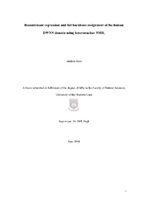| dc.description.abstract | The cellular levels of a number of proteins have been found to be regulated by the ubiquitin-proteasome pathway. In this pathway, proteins are covalently tagged (“ubiquitinated”) by ubiquitin, which acts as a signal for degradation by the proteasome. A number of key cellular processes, including cell-cycle progression, transcription and DNA repair, are regulated in this way. In recent years a number of cellular proteins resembling ubiquitin in structure or function, the so-called ubiquitin-like proteins, have been identified. Ubiquitin-like proteins can be divided into two classes-the so-called “ubiquitin-like modifiers”, which consist of a single domain that structurally resembles ubiquitin, and “ubiquitin-domain” proteins, which are multi-domain proteins, which include domains that resemble ubiquitin. This thesis describes the recombinant expression, purification and full backbone assignment of the human DWNN domain, a novel ubiquitin-like domain. The DWNN domain occurs at the N-terminus of RBBP6, a protein that has been shown to interact with p53 and Rb as well as to be involved in mRNA processing and apoptosis. A bacterial expression system was used to overexpress the DWNN domain as a GST fusion protein. The domain was labelled with 15N and 13C to perform triple-resonance heteronuclear NMR experiments, from which full backbone assignments were obtained. Although full structure determination of the DWNN domain falls outside the scope of this thesis, the backbone assignments formed the basis for the subsequent structure determination, which confirmed that the DWNN domain is indeed a novel ubiquitin-like domain. The RBBP6 protein may therefore represent a novel E3 ubiquitin ligase that plays a role in regulating the cellular levels of p53 and Rb. | en_US |

